Drilling holes in the ground. What secrets are hidden by the Kola superdeep well
General view of the Kola superdeep well complex.
In the depths of the hot ores ...
The 20th century was marked by the triumph of man in the air and the conquest of the deepest troughs of the oceans. Only a dream to penetrate the heart of our planet and to know the hidden life of its bowels hitherto remains unattainable. "Journey to the center of the Earth" promises to be unusually difficult and exciting, fraught with a lot of surprises and incredible discoveries. The first steps on this path have already been taken - several dozen ultra-deep wells have been drilled in the world. The information obtained through super-deep drilling turned out to be so stunning that it shook the well-established notions of geologists about the structure of our planet and provided rich materials for researchers in various fields of knowledge.
Touch the mantle
Hardworking Chinese in the 13th century dug wells 1,200 meters deep. Europeans broke the Chinese record in 1930 by learning how to pierce the earth with the help of rigs for 3 kilometers. In the late 1950s, wells extended to 7 kilometers. The era of super-deep drilling began.
Like most global projects, the idea to drill the upper shell of the Earth arose in the 1960s, at the height of space flights and the belief in the limitless possibilities of science and technology. The Americans decided to go through the entire earth’s crust with a borehole and get samples of rocks of the upper mantle. The ideas about the mantle then (as, by the way, even now) were based only on indirect data - the propagation velocity of seismic waves in the bowels, the change of which was interpreted as the boundary of rock layers of different age and composition. Scientists believed that the earth's crust was like a sandwich: young rocks on top, ancient ones on the bottom. However, only super-deep drilling could give an authentic picture of the structure and composition of the outer shell of the Earth and the upper mantle.
Mokhol Project
In 1958, the US launched the Mohol super-deep drilling program. This is one of the most daring and mysterious projects of post-war America. Like many other programs, Mohol was intended to overtake the USSR in scientific rivalry, setting a world record in ultra-deep drilling. The name of the project comes from the words “Mokhorovichich” - this is the name of the Croatian scientist who identified the interface between the earth’s crust and mantle - the Moho border, and “hole”, which in English means “well”. The creators of the program decided to drill in the ocean, where, according to geophysicists, the earth's crust is much thinner than on the mainland. It was necessary to lower the pipes several kilometers into the water, go 5 kilometers of the ocean floor and reach the upper mantle.
In April 1961, off the island of Guadeloupe in the Caribbean, where the water column reaches 3.5 km, geologists drilled five wells, the deepest of which entered the bottom by 183 meters. According to preliminary calculations, in this place under sedimentary rocks it was expected to meet the upper layer of the earth's crust - granite. But the core raised from the sediment contained pure basalts - a kind of antipode of granites. The result of drilling discouraged and at the same time inspired scientists, they began to prepare a new phase of drilling. But when the project cost exceeded $ 100 million, the US Congress stopped funding. Mokhol did not answer any of the questions posed, but he showed the main thing - ultra-deep drilling in the ocean is possible.
Funeral postponed
Ultra-deep drilling made it possible to look into the bowels and understand how rocks behave at high pressures and temperatures.The idea that rocks become denser with depth and their porosity decreases, was incorrect, as was the point of view about dry bowels. This was first discovered during drilling of the Kola superdeep, other wells in ancient crystalline strata confirmed the fact that, at a depth of many kilometers, rocks are cracked and penetrated by numerous pores, and aqueous solutions move freely under pressure of several hundred atmospheres. This discovery is one of the most important achievements of super-deep drilling. It forced again to address the problem of the disposal of radioactive waste, which was supposed to be placed in deep wells, which seemed completely safe. Given the information on the state of the subsoil obtained during ultra-deep drilling, projects for creating such burial grounds now look very risky.
In search of cooled hell
Since then, the world has contracted super-deep drilling. In the United States, they were preparing a new program for studying the ocean floor (Deep Sea Drilling Project). The Glomar Challenger vessel, specially built for this project, spent several years in the waters of various oceans and seas, having drilled almost 800 wells in their bottom, reaching a maximum depth of 760 m. By the mid-1980s, the results of offshore drilling confirmed the theory of plate tectonics. Geology as a science was born again. Meanwhile, Russia went its own way. The interest in the problem, aroused by the successes of the United States, resulted in the program “Earth bowels and ultra-deep drilling”, but not in the ocean, but on the continent. Despite a long history, continental drilling seemed a completely new thing. After all, it was a question of previously unattainable depths - more than 7 kilometers. In 1962, Nikita Khrushchev approved this program, although he was guided by political rather than scientific motives. He did not want to lag behind the United States.
The newly created laboratory at the Institute of Drilling Engineering was headed by the famous oilman, Doctor of Technical Sciences Nikolai Timofeev. He was instructed to justify the possibility of ultra-deep drilling in crystalline rocks - granites and gneisses. The research took 4 years, and in 1966, experts reached a verdict - you can drill, and not necessarily with tomorrow’s technology, the equipment that is already enough is enough. The main problem is the heat in the deep. According to calculations, as they penetrate into the rocks composing the earth's crust, the temperature should increase every 33 meters by 1 degree. So, at a depth of 10 km, we should expect about 300 ° C, and at 15 km - almost 500 ° C. Drilling tools and devices will not withstand such heating. We had to look for a place where the bowels are not so hot ...
Such a place was found - the ancient crystalline shield of the Kola Peninsula. A report prepared at the Institute of Physics of the Earth said: over the billions of years of its existence, the Kola shield has cooled, the temperature at a depth of 15 km does not exceed 150 ° C. And geophysicists have prepared an approximate section of the Kola Peninsula. According to them, the first 7 kilometers are granite strata of the upper part of the earth's crust, then the basalt layer begins. Then the idea of \u200b\u200bthe two-layer structure of the earth's crust was generally accepted. But as it turned out later, both physicists and geophysicists were mistaken. The site for the rig was chosen at the northern tip of the Kola Peninsula near Lake Wilgiskoddeoainvinjärvi. In Finnish, this means “Under the Wolf Mountain,” although there are no mountains or wolves in that place. Drilling of a well, the design depth of which was 15 kilometers, began in May 1970.
The head of the expedition D. Huberman at the peg in place of the future well.
Swedes Disappointment
In the late 1980s, in Sweden, in search of natural gas of non-biological origin, a well was drilled to a depth of 6.8 km. Geologists decided to test the hypothesis that oil and gas are not formed from dead plants, as most scientists believe, but through mantle fluids - hot mixtures of gases and liquids. Hydrocarbon-saturated fluids seep from the mantle into the earth's crust and accumulate in large quantities. In those years, the idea of \u200b\u200bthe origin of hydrocarbons not from the organic matter of sedimentary strata, but through deep fluids was a novelty; many wanted to test it. It follows from this idea that hydrocarbon reserves can contain not only sedimentary, but also volcanic and metamorphic rocks. That is why Sweden, mostly located on an ancient crystal shield, undertook to conduct an experiment.
For drilling, we chose the crater Siljan Ring with a diameter of 52 km. According to geophysical data, calcined granites were located at a depth of 500-600 meters - a possible tire for the underlying hydrocarbon reservoir. Measurements of the acceleration of gravity, by changing which one can judge the composition and density of rocks lying in the bowels of the earth, indicated the presence of highly porous rocks at a depth of 5 km - a possible reservoir of oil and gas. The results of the drilling disappointed scientists and investors who invested $ 60 million in this work. The passed strata did not contain industrial reserves of hydrocarbons, only manifestations of oil and gas of obviously biological origin from ancient bitumen. In any case, no one was able to prove the opposite.
Tool for the underworld
The creation of fundamentally new devices and giant machines did not require drilling of the Kola well SG-3. We began to work with what we already had: the Uralmash 4E installation with a lifting capacity of 200 tons and alloy pipes. What was really needed at that time was non-standard technological solutions. Indeed, no one drilled in solid crystalline rocks at such a great depth, and what would be there was imagined only in general terms. Experienced drillers, however, realized that no matter how detailed the project, a real well would be much more complicated. After 5 years, when the depth of the SG-3 well exceeded 7 kilometers, a new Uralmash 15,000 drilling rig was installed - one of the most modern at that time. Powerful, reliable, with an automatic tripping mechanism, it could withstand a string of pipes up to 15 km long. The rig turned into a completely sheathed rig 68 m high, rebellious to the strong winds raging in the Arctic. Nearby grew a mini-factory, scientific laboratories and a core storage.
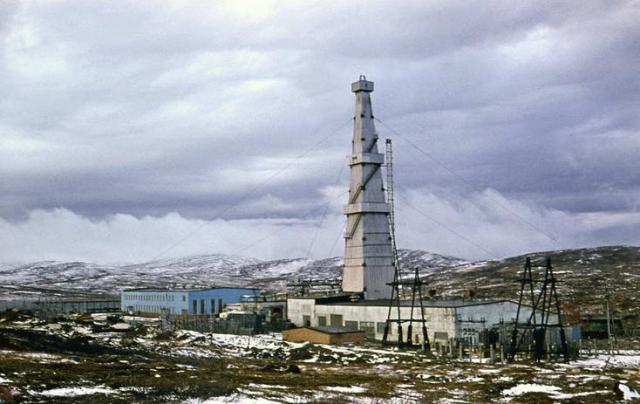
Uralmash 4E installation.
When drilling at shallow depths, a motor that rotates a pipe string with a drill at the end is mounted on the surface. The drill is an iron cylinder with teeth from diamonds or hard alloys - a crown. This crown bites into the rocks and cuts out a thin column - core. To cool the tool and remove small debris from the well, drilling mud is injected into it - liquid clay, which constantly circulates along the trunk, like blood in vessels. After some time, the pipes are raised to the surface, freed from the core, the crown is changed, and the column is again lowered into the face. This is how conventional drilling is done.
And if the trunk length is 10-12 kilometers with a diameter of 215 millimeters? The pipe string becomes the thinnest thread lowered into the well. How to manage it? How to see what is happening in the face? Therefore on Kola well miniature turbines were installed at the bottom of the drill string; they were launched by drilling mud pumped through pipes under pressure. The turbines rotated the carbide crown and cut the core. The whole technology was well worked out, the operator on the control panel saw the rotation of the crown, knew its speed and could control the process.
Every 8-10 meters, a multi-kilometer pipe string had to be lifted up. Descent and ascent took a total of 18 hours.
Diamond dreams of the Volga region
When small diamonds were found in the Nizhny Novgorod Region, geologists were puzzled by this. Of course, it was easiest to assume that the glacier or river water came from somewhere in the north brought precious stones. But suddenly, the local bowels hide a kimberlite pipe - a container of diamonds? They decided to test this hypothesis in the late 1980s, when the scientific drilling program in Russia was gaining momentum. A place for drilling was chosen north of Nizhny Novgorod, in the center of a giant ring structure, which stands out well in the relief. Some considered it a meteorite crater, others - an explosion tube or a vent of a volcano. Drilling was stopped when the Vorotilovskaya well reached a depth of 5,374 m, of which more than a kilometer fell on the crystalline basement rocks. The kimberlites were not found there, but in fairness it should be said that they did not put an end to the dispute about the origin of this structure either. Extracted from the bowels of the facts were equally suitable for the supporters of both hypotheses, as a result, each remained of its own opinion. And the well was turned into a deep geolaboratory, which is still valid today.
Insidious figures "7"
7 kilometers is a mark for the Kola superdeep fatal. Behind it began the unknown, many accidents and a continuous struggle with rocks. The barrel could not be held vertically. When the first time passed 12 km, the well deviated from the vertical by 21 °. Although the drillers had already learned to work with the incredible curvature of the trunk, it was impossible to go further. The well was to drill from the mark of 7 kilometers. To get a vertical shaft in hard rocks, you need a very hard bottom of the drill string so that it goes into the bowels, like in oil. But another problem arises - the well is gradually expanding, the drill hangs in it, like in a glass, the walls of the barrel begin to crumble and can crush the tool. The solution to this problem was original - the pendulum technology was applied. The drill artificially swayed in the well and suppressed strong vibrations. Due to this, the trunk turned out to be vertical.
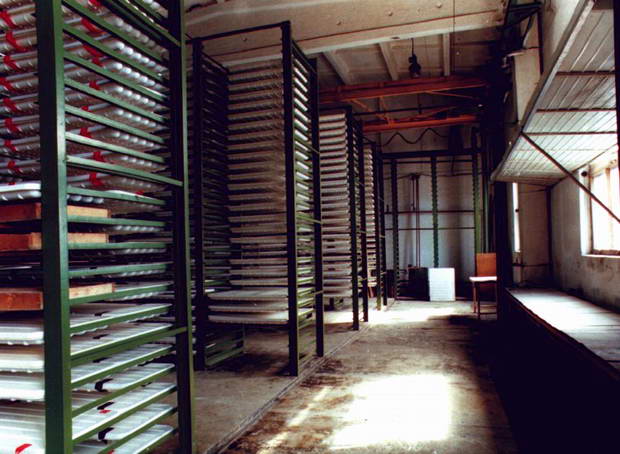
Core storage.
The most common accident at any drilling site is a broken pipe string. Usually they try to capture the pipes again, but if this happens at a great depth, then the problem becomes unrecoverable. It’s useless to search for a tool in a 10-kilometer well, they threw such a trunk and started a new one, a little higher. Breakage and loss of pipes on the SG-3 happened many times. As a result, in its lower part, the well looks like the root system of a giant plant. The branching of the well afflicted the drillers, but it turned out to be a blessing for geologists, who unexpectedly received a three-dimensional picture of an impressive segment of ancient Archean rocks formed over 2.5 billion years ago.
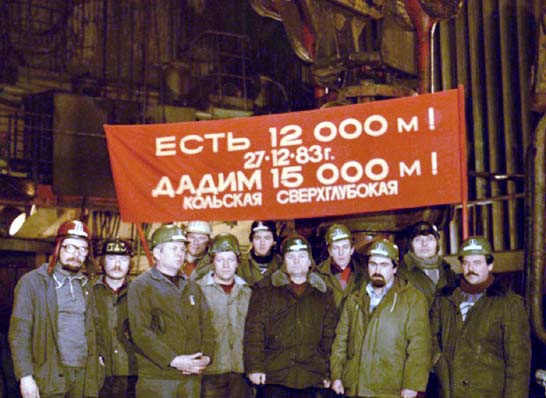
There are 12000 meters!
In June 1990, SG-3 reached a depth of 12,262 m. The well was prepared for driving up to 14 km, and then an accident occurred again - at around 8,550 m, the pipe string broke. Continuation of the work required a long preparation, updating of equipment and new costs. In 1994, the Kola ultra-deep drilling was stopped. After 3 years, she got into the Guinness Book of Records and still remains unsurpassed. Now the well is a laboratory for studying the deep subsurface.
Secret bowels
SG-3 has been a secret target from the start. The border zone, strategic deposits in the okrug, and scientific priority are to blame. The first foreigner to visit the rig was one of the leaders of the Academy of Sciences of Czechoslovakia. Later, in 1975, an article about Pravda was published about the Kola Superdeep, signed by Minister of Geology Alexander Sidorenko. There were still no scientific publications on the Kola well, but some information was leaking abroad. More rumored the world began to learn - in the USSR they drill the deepest well.
Extracted core.
A veil of secrecy would probably hang over the well until the “perestroika”, if the World Geological Congress did not happen in 1984 in Moscow. They carefully prepared for such a major event in the scientific world, they even built a new building for the Ministry of Geology - many participants expected it. But foreign colleagues were primarily interested in the Kola superdeep! The Americans generally did not believe that we have it. The well depth by that time reached 12 066 meters. Hiding the object no longer made sense. An exhibition of achievements of Russian geology was waiting for the congress participants in Moscow, one of the stands was dedicated to the SG-3 well. Experts all over the world looked perplexedly at a conventional drill head with worn out carbide teeth. And with this they drill the deepest well in the world? Unbelievable! A large delegation of geologists and journalists went to the village of Zapolyarny. Visitors were shown the rig in action, 33-meter pipe sections were removed and disconnected. Around him were piles of exactly the same drill heads as the one on the stand in Moscow.
The delegation from the Academy of Sciences was received by the famous geologist, academician Vladimir Belousov. During a press conference from the audience he was asked a question:
- What is the most important thing shown by the Kola well?
- Gentlemen! The main thing is that it showed that we do not know anything about the continental crust, ”the scientist honestly answered.
Deep surprise
Of course, they knew something about the crust of the continents. The fact that the continents are composed of very ancient rocks, from 1.5 to 3 billion years old, has not been refuted even by the Kola well. However, the geological section compiled on the basis of the SG-3 core turned out to be exactly the opposite of what scientists had previously imagined. The first 7 kilometers were composed of volcanic and sedimentary rocks: tuffs, basalts, breccias, sandstones, dolomites. Deeper lay the so-called Conrad section, after which the speed of seismic waves in the rocks increased sharply, which was interpreted as the boundary between granites and basalts. This section was passed long ago, but the basalts of the lower layer of the earth's crust never appeared anywhere. On the contrary, granites and gneisses began.
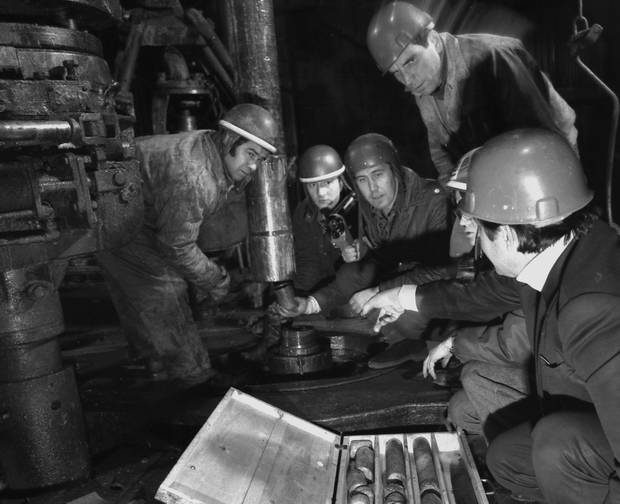
Core extraction.
The Kola well section disproved the two-layer model of the earth's crust and showed that seismic sections in the bowels are not boundaries of layers of rocks of different compositions. Rather, they indicate a change in the properties of the stone with depth. At high pressure and temperature, the properties of the rocks, apparently, can change dramatically, so that granites in their physical characteristics become similar to basalts, and vice versa. But “basalt”, raised to the surface from a 12-kilometer depth, immediately became granite, although it experienced a severe attack of “caisson disease” along the way - the core crumbled and disintegrated into flat plaques. The farther the well went, the less quality samples fell into the hands of scientists.
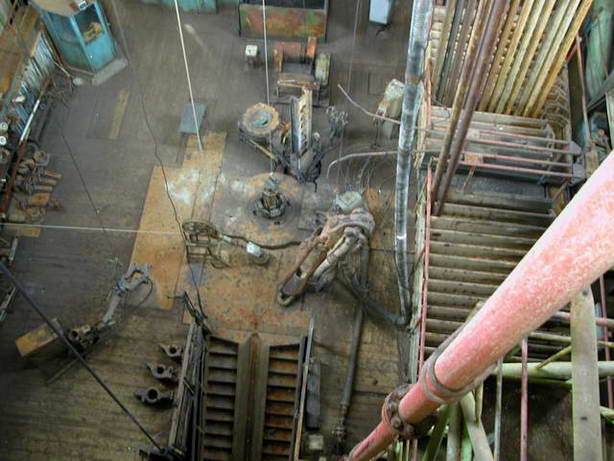
Drilling.
The depth contained many surprises. It used to be natural to think that with distance from the surface of the earth, with increasing pressure, the rocks become more monolithic, with a small number of cracks and pores. SG-3 convinced scientists of the opposite. Starting from 9 kilometers, the strata turned out to be very porous and literally crammed with cracks along which aqueous solutions circulated. Later this fact was confirmed by other superdeep wells on the continents. At depth it turned out to be much hotter than expected: as much as 80 °! At the level of 7 km, the temperature in the face was 120 ° С, at 12 km it reached 230 ° С. In samples of the Kola well, scientists discovered gold mineralization. Blotches of precious metal were found in ancient rocks at a depth of 9.5-10.5 km. However, the concentration of gold was too low to claim a deposit - an average of 37.7 mg per ton of rock, but sufficient to expect it in other similar places.
P.S. I also want to add an audio recording made to depth
one more sound, but already seasoned with comments, though in English (probably in this case we are talking about the Ural ultra-deep well (SG-4))
Source http://via-midgard.info/
Kola superdeep well (SG-3) is the deepest borehole in the world. It is located in the Murmansk region, 10 kilometers west of the city of Zapolyarny, on the territory of the Baltic Shield. Its depth is 12,262 meters. Unlike other super-deep wells, which were made for oil production or exploration, SG-3 was drilled exclusively to study the lithosphere in the place where the boundary of Mokhorovichich comes close to the Earth's surface.
The thickness of sedimentary rocks by that time was well studied in oil production. It was more interesting to drill where volcanic rocks about 3 billion years old (for comparison: the Earth’s age is estimated at 4.5 billion years) come to the surface. For mining, such rocks rarely drill deeper than 1-2 km. It was assumed that already at a depth of 5 km the granite layer will be replaced by basalt.
The Kola superdeep served as the source of the urban legend of the "road to hell" (Well to Hell hoax). This urban legend has been on the Internet since at least 1997. According to this legend, in the thickest of the earth, at a depth of 12 thousand meters, the microphones of scientists recorded screams and groans. In the tabloid newspapers they write that it is a "voice from the underworld." The Kola superdeep well was called the "road to hell" - each new drilled kilometer brought misfortune to the country. When the drillers were driving thirteen thousand meters, the USSR collapsed. When the well was drilled to a depth of 14.5 km, they suddenly stumbled upon voids. Intrigued by this unexpected discovery, the drillers lowered a microphone there, capable of operating at extremely high temperatures, and other sensors. The temperature inside reached 1,100 ° C - there was a heat of fire chambers, in which, allegedly, one could hear human cries.
In the late 80s, reports appeared in the foreign press that the Russians had drilled a hole in the underworld. So they talked about the deepest Kola well. Allegedly, the scientists lowered the microphone to a depth of over 10 kilometers and recorded terrible sounds. On a magnetic record - whistles, rattle, groans, heartbreaking screams of men and women. It was as if the drill had fallen into real biblical hell, where sinners were immersed in boiling resin. Therefore, they say, they didn’t continue to “hole the earth” ...
OTHER SOURCE
In fact, in the 70s, in the northwest of the Kola Peninsula, they began to drill the deepest well in the world in order to study the Earth's bowels in more detail. Rock cores taken from drill pipes were laid out in boxes in a certain order. Sensors were periodically lowered into the well to measure the temperature of each successive horizon. In 1991, her face reached 12,261 meters. The continuous section of two ancient complexes was discovered for the first time in a time interval of 3 to 1.6 billion years. The giant rig, twenty-story-tall, will probably stand for many more years as a monument to the record of drilling depth reached here.
This information about “voices from underground” is not unique. For example, Muscovite Stanislav Dolger says: “My wife and I bought a summer cottage, and began to equip it. Since water had to go half a kilometer to the nearest column, the first question for us was the well. We found out from the neighbors that the water in our area is about seven meters. In the spring I ordered eight concrete rings. I decided to do everything myself. Digging on weekends, without rushing. Over the weekend, buried a meter in depth, and then for a week left for the capital, giving the rings the opportunity to calmly and evenly settle.
Oddities began with the sixth ring - at a depth of six meters I suddenly began to hear voices. The speech was rude, jerky, reminiscent of German. The voices sounded different - male, female, children's. And not always, but as usually happens in any house: sometimes everyone is busy and silence reigns, otherwise suddenly a dispute arises and individual phrases are heard. One after another, interrupting, overlapping one another.
What I just did not change my mind about this. At first, of course, he decided that his wife was talking to someone outside. Then he began to sin on his own mind. However, it soon became clear that I did not imagine. Firstly, I heard voices only below, and nowhere else. Secondly, when it rose, they became quieter and more muffled, remaining below. That is, the voices were not tied to my head, but to a specific place. I even tried a psychotropic stimulant - I grunted two hundred grams of vodka and went downstairs. Voices were heard in the same way as sobriety. He wanted to lower his wife so she also listened - but she was afraid of the depths.
Then there were other thoughts - like that there was some secret bunker, a secret mine below. However, no one had ever heard of anything similar in the village or around. Ideas like telephone cables lying below, and conversations reflected in my brain, also had to be thrown back - who would begin to dig in the wires for six meters. The most plausible thought seemed to me that I came across a dwelling of some gnomes or some underground creatures. Or, more precisely, dug somewhere very close.
Upstairs, it was hard to believe in such things - but when you sit deep underground, while someone is chatting over the ear itself - everything is perceived somewhat differently. I even took a week digging, expecting if something bad would happen. But on the site and around everything remained calm. And I began to dig a well further, every minute expecting some surprises. But nothing happened - except for lively comments in an unfamiliar language almost overhead. Nevertheless, I stubbornly buried another meter and on Sunday evening left for the city. When he arrived at the cottage six days later, water was already splashing in the well. No more voices came from there, the water in it turned out to be the most ordinary (I passed it to the SES for analysis). ”
edited news Mr. bubble - 21-09-2010, 20:31
Title Mohole complex. “Hole” means a hole or simply a hole, and the first syllable “Mo” is taken from the name of the outstanding Croatian geophysicist Andrei Mokhorovich. Thanks to him, the concept of the surface of Mokhorovichich came into scientific use. This is the name of the mysterious underground region, presumably the lower boundary of the earth's crust, on which there is an abrupt increase in the velocities of longitudinal seismic waves from 6.7–7.6 to 7.9–8.2 km / s and transverse from 3.6–4. 2 to 4.4-4.7 km / s. The density of the substance also increases abruptly, presumably from 2.9-3 to 3.1-3.5 t / m³. The purpose of the project "Mohol" was precisely to reach this surface and for the first time to get a visual, and not just speculative, view of it.
CUSS I Drilling Platform, Project Mohole
It was believed that this would be easier to achieve by starting drilling on the ocean floor, where the crust is much thinner. A place was chosen near the island of Guadalupe with an ocean depth of about 3.5 km. However, only 5 test wells were drilled with a bottom depth of up to 180 meters. After that, the project, alas, had to be closed due to cost overruns.
In the years 1973-1974. in Oklahoma, a well was drilled by Bertha Rogers. Her mission was more prosaic - oil production, but the project also had a research load. Berta Rogers reached a depth of 9583 m and for the time being it remained the deepest well in the world.
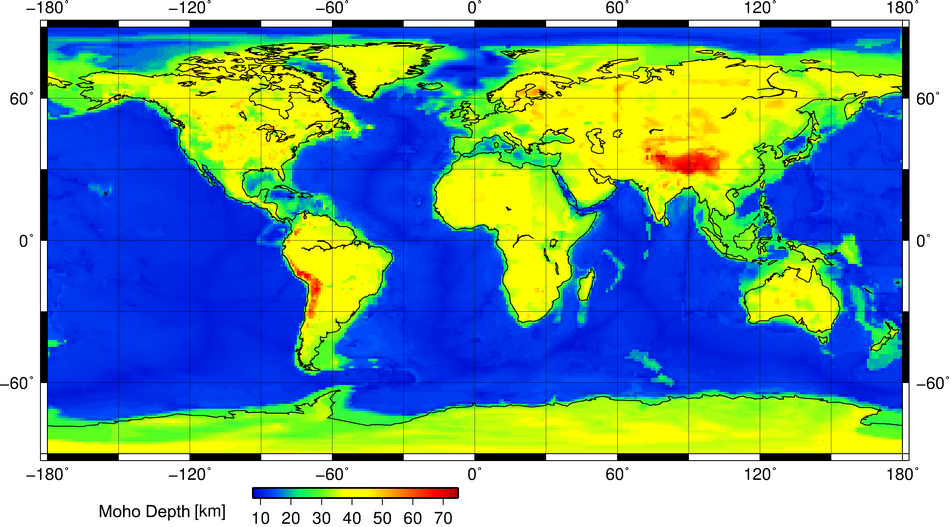
Meanwhile, a project was launched in the USSR to create about 30 ultra-deep (over 5 km) wells in various regions of the country. Mostly they were oil producers, but not all. In 1974, the deepest of them had a depth of 7263. It was the Kola superdeep well, which occupied a special place in the Soviet deep drilling program. It was not intended for oil production, but exclusively for scientific research.
The Kola superdeep was laid in 1970 in the north-eastern part of the Baltic Shield, in a place where the oldest igneous rocks come to the surface, little studied in mining, which is often carried out in sedimentary strata. Moreover, the border of Mokhorovichich passes here shallow (relatively, of course).

Swung for 15 km. The tasks assigned to the project participants included the practice of confirming or refuting a number of theories, identifying features of ore formation processes, determining the nature of the boundaries separating the layers in the continental crust, and collecting data on the material composition and physical condition of rocks.
Drilling began on May 24th. The diameter of the inlet was 92 cm. At first, the work was carried out by a serial unit, which is usually used in oil and gas production. Then it was replaced by equipment specially developed by Uralmash from light but strong alloys. Otherwise, when lifting from the depths, it would not have sustained its own weight.
The drill methodically pierced ancient granites, whose age exceeded 3 billion years. There was no shortage of surprises. The permanent leader of the well, David Mironovich Huberman, told in an interview to Murmansk Bulletin in 2011:
We drilled and did not know what awaited us. At a depth of 1700 meters found deposits rich in nickel. Here are the job prospects for our plants! Digging on. And at three kilometers we got to the moon! Pure moon! - says David Mironovich and laughs: - Then we already had lunar soil. We compared it with what we lifted from three kilometers, in all physical and mechanical properties - one to one. My comrades and I were joking that the Moon supposedly broke away from the Kola Peninsula! It remains only to find a place from where she broke away ...
Later, miracles began at all, refuting many generally accepted theories. It was believed that at a five-kilometer depth granite will be replaced by basalts. At this depth, as well as at the border of Mokhorovichich, the instruments recorded a sharp increase in the speed of passage of seismic waves. This phenomenon, known as the Konrad surface, was explained by the fact that here the upper granite layer of the earth's crust is replaced by lower basalt. However, drilling did not confirm this. The 5 km mark was left behind, and the installation still extracted granite core (cylindrical rock columns intended for scientific analysis) to the surface. True, this granite was more and more unusual, compressed by high pressure, which changed its physical and acoustic properties. But truly significant metamorphoses began only at the eighth kilometer, moreover, not at all what the geologists predicted. Now drilling went not through granites, but not through basalts, but through gneisses - a layered rock with a density very low for such a depth. The wellbore began to crumble, and then the drill string stuck with the rock, and the head was cut off when trying to climb. This did not discourage researchers. The lost part of the drill string was cemented, drilling continued with the deviation of the drilling tool.
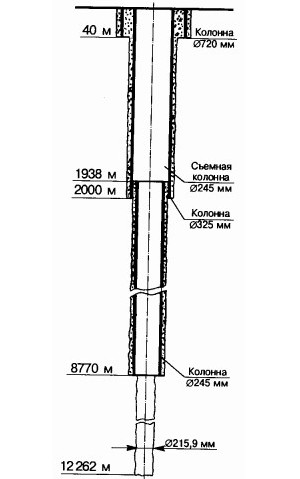
Nedra Publishing House, 1984
Vladimir Basovich, Deputy Director for Research at the Kola Superdeep Well, recalls:
We had our own design bureau, we had our own programmers, we had our own workshop, we had our own forge, termichka, whatever you want. Now a need arose, an idea - tomorrow it turned into blueprints. Two days later, we made it ourselves. Four days later, we let her into unknown depths, into unprecedentedly critical operating conditions.
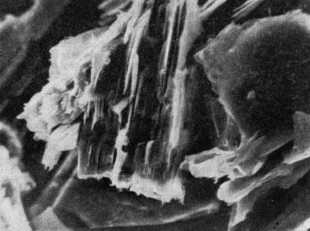
Photo: “Kola Superdeep” Ministry of Geology of the USSR,
nedra Publishing House, 1984
Surprise from what he saw increased. The rock turned out to be porous and fractured, and the voids were filled with water, which they did not expect to find in such quantity at such a depth. In the process, the temperature was measured throughout the wellbore, natural radioactivity — gamma radiation, induced radioactivity after pulsed neutron irradiation, the electrical and magnetic properties of the rocks, the propagation velocity of elastic waves, and the composition of the gases in the well fluid was investigated. There were surprises too. The temperature grew much faster than predicted, and radioactivity did not want to behave as expected.
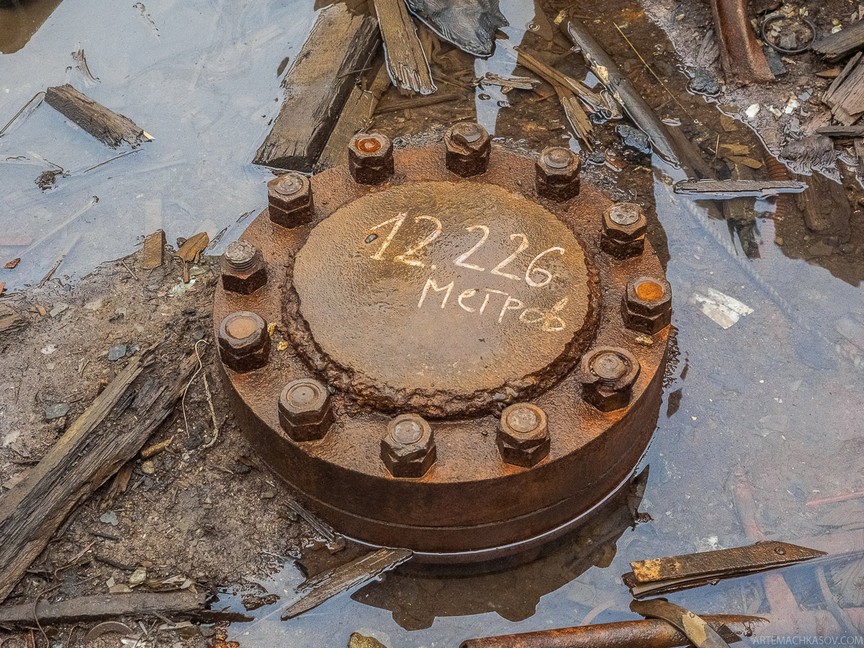
On June 6, 1979, Soviet drillers broke Bert Rogers' record and moved on. By 1984, the well depth exceeded 12 km. At the thirteenth kilometer, accidents began to follow one after another. After all, a damn dozen. At this stage, an amusing urban legend arose, later quite seriously replicated first by the Western and then by the post-Soviet press: Soviet drillers pierced the roof of hell, and the sound recording equipment lowered into the well recorded the cries of sinners suffering there. Allegedly, this was the reason for the cessation of work and the closure of the well. But drilling had to be stopped for a completely materialistic reason: technical difficulties exceeded all conceivable limits. Raising rocks and the drill head from such a depth is in itself unthinkable. Add to this the high temperatures and pressures. And the inevitable differences in these indicators when climbing to the surface. Actually, long before reaching the “damn dozen”, drilling turned into a desperately extreme activity. 50 km of pipes were used to dig the last 5 km of the well. Such was the degree of their wear.
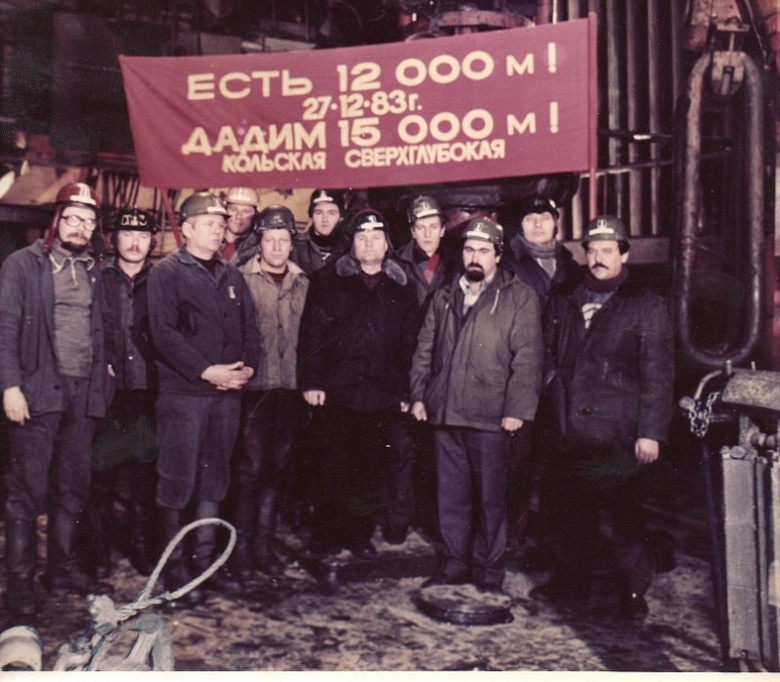
In September 1984, the drill string broke again, and so unsuccessfully that five kilometers of pipes that came off were stuck in the well, blocking it firmly. Drilling began almost anew from a depth of 7000 m - and by 1990 a new branch reached a depth of 12,262 m, but here the string broke again. This time, the resumption of work was recognized impossible. It’s a pity, but the Kola superdeep has become a unique scientific and technological achievement, not only to surpass, but even to repeat which no one has managed so far. But almost half a century has passed since the start! To date, there are a couple of oil wells that are longer than Kola in length, but they run at an angle to the surface and do not penetrate so deep into the bowels of the earth.
Drilling was completed, but this should not have meant the completion of a research project. A unique twelve-kilometer core, divided into separate columns and numbered, was laid out in nine hundred boxes. They are stored in Yaroslavl. A thorough study of this invaluable material is ongoing, and is likely to continue for a long time to come. The situation is worse with the well itself. Even in the course of work, it served as a deep observatory, where instruments were installed at different levels that recorded the characteristics of the propagation of seismic waves and a bunch of other indicators. Moreover, all this was part of a single system of deep observatories operating in three dozen other superdeep wells located thousands of kilometers apart. The information collected in this way allowed significant progress in the difficult task of earthquake prediction. Also, observatories recorded the features of the propagation of waves from underground nuclear explosions, over vast distances and depths. Among other things, this allowed us to compile in-depth maps of possible mineral deposits, which were then transferred to practical geologists.
We got very interesting cuts. Based on these sections, we could seriously judge the structure of the earth's crust. Even up to one hundred and fifty kilometers. This opened up new opportunities for global exploration of the territory of the Soviet Union.- Evgeny Kozlovsky, former Minister of Geology of the USSR, testifies.
Kola is superdeep and now could serve as a unique deep observatory. Could, but does not serve. They stopped financing it, closed it, and the ground complex with unique equipment was sawn into scrap metal. In an interview with Murmansk Gazette, which turned out to be the last, David Mironovich Huberman said:
Oh, because in order to maintain it, not destroy it, we needed a penny — three million, not dollars, ours, “wooden” rubles. Not given, saved! And they got what they wanted ... Everyone says that, they say, it costs a lot. Knowledge is expensive. That's right. Why doesn’t anyone say how much ignorance costs ?! Much more. You look at what happened in Japan when there were accidents at nuclear power plants ... I don’t understand! We were worth a penny! Drilling was cheap, all the equipment was domestic, not a single imported nail. No, they canned, closed, people were fired! You see, all this is nonsense, that there is no money for science! Nonsense, we did not ask much. But what a return ... And now you can install scientific equipment there, lower the sensors to a depth and take measurements. Priceless information. According to the forecast of the same earthquakes ...

Now the people are walking on the ironic interpretation of the abbreviation of the Russian Federation - Resource Federation. Those who repeat this unkind joke seem to imagine that the resources of this Federation itself are simply lying in the open. Come out, pick it up with your bare hands and put it in containers. But all these notorious resources became available only thanks to the colossal work done by scientists and engineers. What power was plucked into geological exploration, what intelligence! And with what thoughtless recklessness it then went to the dog under the tail! I really want to believe that the heirs, finally, have become smarter, and will not squander, what is left is absolutely mediocre. It is believed that the Kola superdeep can still be restored at least as an institution for the training of offshore drilling specialists. And maybe not only. They say that at least 8 km in depth the wellbore is now quite “alive” and suitable for geophysical exploration. Restoring the destroyed, of course, will cost a lot, but it is possible.
Drilling pits under the pillars of the fence and foundation
Drilling holes in the ground is a necessary part of any construction work: installing poles for fences, foundation work, installing poles for power lines - drilling is necessary for all these works.
You can drill holes of different depths and diameters with the help of a Yamobur - a special mechanism designed for drilling. There are two types of pit drills: manual motor drills (gas drills) and crane-based drill rigs based on cars.
Drilling pits with a gas drill (motor drill)
The principle of operation of a manual mobile Yamobur is extremely simple and understandable: the auger (auger) enters the soil and, deepening deeper, throws out the worked out soil. Manual Yamobur (motor drill) consists of two main components: a drill (auger) and a drive in the form of a gasoline or electric engine. The power of the unit depends on the drive, therefore, its productivity. The engine torque is transmitted to the auger through a system of shafts and gearboxes. Manual gas drill is used on almost any type of soil, and is suitable for drilling in shallow holes - from 1.5 to 3 m. Most often, such devices are used when , excavation for planting large plants, drilling pits and other works where shallow wells are required.
The cost of manual and automotive drilling
The type of soil, the presence of cultural layers, rock, complicating the drilling process, affects the cost of drilling. The price is calculated by the company manager on the basis of many parameters: depth, diameter of drilling, nature and parameters of terrain (stones, tree roots), the location of the object.
The price of drilling with a manual gas drill
|
Hole drilling diameter |
up to 20 holes |
21 to 50 holes |
over 51 holes |
|
Hole drilling depth up to 0.9 meters |
|||
|
350 rub |
300 rub |
250 rub |
|
|
370 RUB |
350 rub |
250 rub |
|
|
400 rub |
370 RUB |
300 rub |
|
|
450 rub |
400 rub |
350 rub |
|
|
Hole drilling depth from 1 to 1.9 meters |
|||
|
Drilling holes with a diameter of 100 mm |
400 rub |
350 rub |
300 rub |
|
Drilling holes with a diameter of 150 mm |
450 rub |
400 rub |
350 rub |
|
Drilling holes with a diameter of 200 mm |
500 rub |
450 rub |
400 rub |
|
Drilling holes with a diameter of 300 mm |
550 rub |
500 rub |
450 rub |
Automobile Based Drilling
For drilling deep holes, as well as large-diameter holes, pits are used, which are installed on mobile equipment. It is also advisable to use automobile pit drills to carry out large volumes of work: for installing electric lighting poles, for the construction of large facilities, for the construction of pile foundations. The use of crane-drilling machines reduces construction time and increases productivity, which reduces production costs. Yamoburas on the basis of construction equipment perform the following types of work:
- installation of lighting poles;
- installation of power transmission towers;
- drilling under the pillars for the fence;
- installation and screwing of screw piles;
- installation of screw supports;
- screw drilling;
- sheet piling of pits and trenches.
ZABORIVOROTA company carries out drilling with pits:
Yamobur BM-302 on the basis of the Gaz-66 car allows you to dig soil to a depth of 3 m, while making wells up to 1 m in diameter. Yamobur BM-302 on Gaz-66 is used for bulk foundation work, for example, when drilling pits for supporting pillars in regions where the soil freezes to great depths.
The price of drilling a Yamobur BM-302 based on the Gas-66 car
|
12,000 rub. |
|
|
Two-way delivery from MKAD to the facility |
70 rub / km |
Yamobur TADANO equipped with a telescopic boom feed boom. A similar technique is used in cases where you need to remove soil to a depth of 10 m. Yamobur TADANO is suitable for drilling wells for oil pipelines, pile foundations, power lines, bridge supports and crossings.
The price of drilling a Yamobur TADANO
|
The cost of 1 machine change (8 hours) |
Foundation hole drilling During the construction of columnar and strip-columnar foundations, holes are also drilled, and their depth varies depending on the type of foundation and soil condition: the maximum drilling depth can reach 3 m.To build a columnar foundation of brick when dressing with pick-up, an ordinary manual pit drill is sufficient. The same applies to the strip-column foundation, where the diameter of the holes does not exceed 300 mm. If the foundation is constructed from other materials, automotive drills are used that can provide a larger hole diameter - more than 400 mm. TISE Hole Drilling This technology for installing fence posts and foundations is used on heaving, clay and heavy soils. Well drilling is carried out using the manual drills TISE-2F and TISE-3F, which allow you to make holes with a diameter of 200-250 mm. The maximum depth of the wells after applying these boreholes can reach 3 m. After the vertical borehole is completed using a conventional auger, a folding plow is attached to the borehole, allowing hemispherical expansion at the bottom of the hole to be performed inside the borehole. Due to this feature of the technology, reinforced concrete poles are not squeezed out of the ground by frost heaving. After that, a “shirt” is made of roofing or glassine in the wells, which will isolate concrete from the soil and allow the heaving soils to freely slide along the piles. Concrete is poured into the wells after being reinforced with U-brackets. In order for the foundation using TISE technology to become suitable for the construction of buildings on it, it is necessary to build grillages between pillars - supporting structures for walls. For this, you can use ready-made reinforced concrete blocks or perform a monolithic grillage in place. For this, wooden formwork with a height of at least 300 mm and a width of at least 400 mm is used. Grillages are installed from the ground at a height of at least 10-15 cm. Drilling under power transmission poles Installation of power lines (power lines) is strictly controlled by the state, so the process of their installation should be as technologically advanced. For drilling, automobile pits are used, which can provide not only drilling, but also the installation of power transmission poles. Depending on the type of support, wells with a diameter of 250-800 mm and a depth of up to 7 m are made under power transmission poles. The BM-302 automobile Yamobur based on the Gaz-66 automobile and TADANO Yamobur are optimal holes for drilling wells under power transmission poles. Drilling services, rental of crane machines ZABORIVOROTA company offers services for drilling holes in the ground with the help of various types of drilling holes in Moscow, Moscow Region and neighboring regions. Rental conditions for pits and ordering a hole drilling service should be checked with the company's managers. |
As you know, drilling the earth, more precisely, pit in the ground, is often a necessary initial stage of various construction work on the site.
This process occurs using not only the necessary equipment, but also through well-chosen specialists who are qualified in one or another type of work. But now we will touch upon such an urgent topic as the drilling process for pit posts.
1 Why drill holes?
Of course, the presence of a fence (for example, an iron tension grid of a chain-link or wooden) requires us to carry out certain work with our own hands on a designated area of \u200b\u200bland. It is for this that the procedure of drilling wells under the pillars (more precisely, holes of a certain depth) is necessary.
We will consider the drilling process itself by the example of installing columns on the summer cottage for the fence from the netting netting.
First we need to make a certain calculation. For example, you need to fence a certain garden or garden plot with an area of \u200b\u200b6 acres. It turns out that the width of the land is 20 meters, the length is 30 meters.
For the normal installation of the fence with your own hands, you will need to drill holes and hammer piles located at a distance of 2.5 meters from each other. To this value, you also need to add another wicket 1 m wide, as well as a gate 3 m wide. As you can see, in this case it is necessary to drill additional holes for poles in order to install the individual elements of the fence mentioned above.
Using simple calculations, we obtain the following result: to install a fence with your own hands, as well as its components (such as a fence and a gate), you will need to drill about 40 holes.
When drilling land under poles, the main thing to consider is the following parameters:
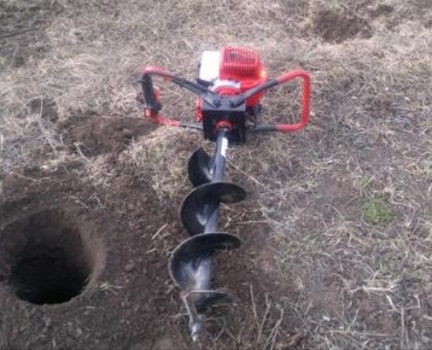
- the height and width of the future fence;
- type of materials the fence is made of (wood, stone, iron, etc.);
- soil condition;
- equipment that will be drilled (a special drill for poles is often used).
2 Calculation of drilling depth
In order to calculate the depth during drilling and installation of poles, we need to carry out a number of certain calculations. For example, take the fencing of a piece of land with our own hands in a galvanized wire netting, the height of which is 1.5 meters.
Most manufacturers and sellers for its fastening offer precisely metal posts (or piles) 2.4 meters high. Based on these indicators, it can be calculated that drilling for the foundation piles should be carried out to a depth of 80 cm.
2.1 Equipment for drilling holes
Do-it-yourself installation of the fence implies carrying out work on drilling holes (or holes) under the posts for the future fence. At first glance, no difficulties should arise in this. But if the garden plot, for example, does not consist of soft and fluffy black soil or sand, but of hard viscous clay, then a shovel would simply be inappropriate.
Firstly, you will spend a lot of effort digging a hole 80 cm deep, and secondly, the width of the hole will not coincide with the diameter of the pile to be mounted. Therefore, the only way out in this situation will be to purchase a manual punch. Using it, the drilling process for you will be greatly simplified. This unit can be both homemade, and factory.
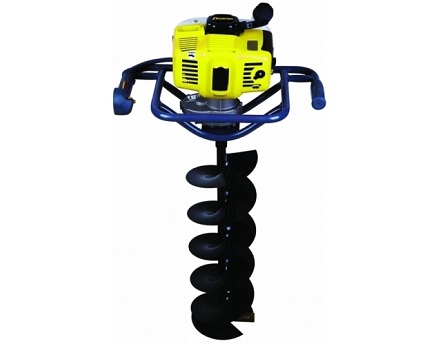
But, as the people say, progress does not stand still, and instead of manual, you can buy a gas drill. In cost, it is slightly different, since it is more expensive than a manual unit. Such a gas drill is suitable even for very hard clay soil. And the process of drilling and installing the fence with your own hands will take you from 1 to 2 days. Therefore, without even doubting, you need to purchase a manual gas drill.
In addition to the above drilling units, you may be interested in such an option as a garden manual pit. It is a simple metal structure consisting of 3 main parts:
- the drill itself with a screw itself, whose length reaches 1 meter and a diameter of 150 millimeters;
- handle pipe, which is wound on a home-made garden Yamobur;
- extension cord that can be wound. It comes in the form of a pipe up to 1 meter long.
Such a simple construction, consisting of 3 parts, can weigh about 10 kg and allows you to drill a hole (or hole) for a pile up to 2 meters deep.
However, choosing a manual garden pit, you must remember about its service life. Because often, after half a year of using such an aggregate, you can notice that the drilling process is becoming more difficult, and the earth is not amenable to penetration. “What is the matter ?!” you will think.
The thing is that homemade manual Yamobur is designed for a certain amount of drilling and, often, just do not have sharpening. In other words, manufacturers never sharpen that part of the auger of the drill, responsible for “biting” the unit into the ground and cutting off its layers. Therefore, you need to periodically sharpen not only a cheap manual garden drill, but also an expensive gas drill.
There are two ways to sharpen a drilling unit. The first is the use of an angle grinder. In the people it is called a grinder, which allows you to sharpen your Yamobur without much effort. For such a responsible and unhurried work, you will need only 5-10 minutes. And as a result, the blades are sharp, like a knife.
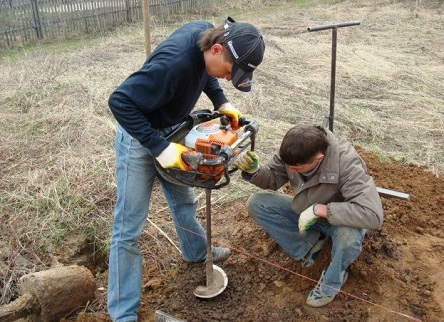
The second method is different in that you grind the drill with your own hands with the help of a regular file, designed for rough polishing and metal processing. The only disadvantage of this method of sharpening is the slow pace of work. On average, it takes from 30 minutes to 2 hours to sharpen.
And now, when your gas drill is already ready for work, and you have decided on the depth to which the piles will be driving the depth for the future fence, you can safely start drilling holes.
2.2 Stages of drilling operations
When you need to drill holes (pits) under the piles of the future fence, it is necessary to carry out certain steps:
- mark the area for future piles (in other words, outline the places where you need to drill). We pay attention to the type of soil in order to calculate our strength and time for carrying out this type of work;
- we prepare the gas drill for earthwork (we sharpen and lubricate it);
- we begin to drill the soil, slowly delving deeper into the soil of the earth, gradually removing its layers;
- after you have crossed the threshold of 30-40 centimeters and feel certain difficulties in further deepening, you need to take water and pour it into the formed hole. This allows you to soften the soil. Thanks to this, your gas drill will begin to drill faster;
- after the main work of the drill has completed, you proceed to the stage of installation of piles (or poles).
Following these steps, you will not only quickly mount the piles and install the fence, but also save your money, since this type of drilling work can be done independently. The main thing is that at hand there is always a good and sharp gas drill. With it, you quickly drill holes under the fence posts and get a reliable fence. A gas drill will help you with this.
If you find it difficult to drill holes under the fence, then you can take the help of highly qualified specialists who will help you with this.
